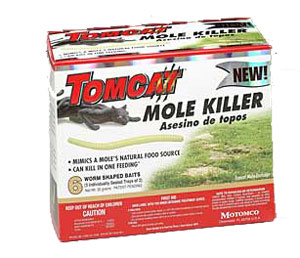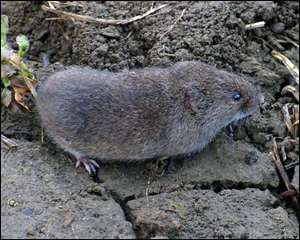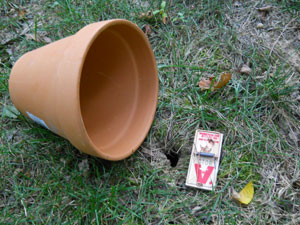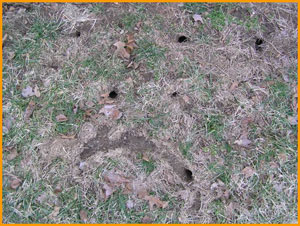Taking an environmentally sensitive approach to pest management
What a Season for Moles and Voles!
Published: October 1, 2011
 Moles:
Moles:
Moles have been very active over the past several years. Activity in the late fall and early winter months is not uncommon as moles prepare for winter hibernation. Many lawns are heaved with feeding runways and mounds to the point that it is difficult to walk. Excess rainfall in the spring and fall will trigger mole activity since their primary food source (earthworms) generally retreats to the surface escaping saturated soils.
Many individuals think moles feed primarily on the roots of plants causing them to die. The truth is, moles' feeding on plant material is very limited. It's the air pockets they create around roots of flowers and other ornamental plants that cause them to dry out and die. Others say that mole activity is strictly tied to the existence of white grubs and will purchase grub insecticides not realizing that these products will reduce earthworm populations up to 70 percent. Mole activity decreases simply because you eliminated their primary food source. Therefore, we do not recommend the use of grub insecticides for the control of moles. Many individuals have their own home remedies to control or repel moles. Several of these include such things as human hair, Juicy Fruit gum, poison peanuts, mothballs, flooding tunnels with a garden hose and water, a hose connected to a cars exhaust and finally, pets (some dogs and/or cats can be effective). Just keep in mind that moles are carnivores and that is why several baits are in-effective.
Moles construct networks of tunnels in the soil surface. Many of these are built after rains when the mole is in search of new sources of food and are usually not re-used day to day. Digging of surface tunnels normally proceeds at a rate of 1 foot per minute. They tend to feed and rest on two-hour cycles, 24 hours a day. Living foods (earthworms and other insects) constitute about 85 percent of their diet; however millipedes, centipedes, spiders, sow bugs, snails and slugs are taken in considerable amounts. Moles are insatiable eaters and can consume 70 to 80 percent of their body weight daily. Moles generally move up or down within the soil profile following their food sources such as earthworms, which moves with soil moisture.
Moles also create mounds (called molehills) of soil in the lawn by pushing up soil developing deeper, permanent tunnels for nesting and hibernating cavities. Mating occurs in the spring with a single annual litter of 2 to 5 young being produced in March, April or the first week of May.

Management or Control:
There are products on the market that are available to homeowners at local nurseries or garden centers.
Many repellant-type products are based on castor bean oil. Many have been tested on the Eastern mole and appear effective on that species, which is our predominant species. These products need to be sprayed (garden hose-end applicator) or granule applied (through a spreader) at regular intervals to maintain a barrier that repels these small mammals to your neighbor.
The repellant type products are marketed as natural and safe, but information about effectiveness is mixed. Chase, Scoot Mole, Shotgun Mole & Gopher Repellant, Mole Max, Mole-Out, Whole Control, and Schultz Garden Safe Mole Repellant are just a few presently available. These products will generally treat 5,000 to 10,000 square feet and last one to three months.
More recent products include several baits that seem to be very effective if applied properly to active feeding runways. See below on how to locate active feeding runways. Wear rubber gloves whenever handling and placing baits in tunnels. This will prevent placing human scent on the bait.
Two products called "Kaput Mole Control" (Lesco) and "Moletox Baited Gel" (Bonide) are water-based gels containing warfarin (0.025%) as the active ingredient and flavored like their primary food, earthworms. It is best to locate the active runways as you would for trapping before placement of the bait. They are both packaged in syringe-type applicators with which the bait is injected into the tunnels.
The latest mole baits registered are worm-shaped baits (Talpirid, MOTOMCO Mole Killer, and Tomcat Mole Killer) containing a bromethalin-based active ingredient that actually looks, feels and tastes like earthworms. Each worm contains a lethal dose of bromethalin. It is the only mole bait that has submitted efficacy studies to EPA.

MOTOMCO Mole Killer and Tomcat Mole Killer are similar baits to Talpirid, but in a more affordable package of six or eight worms. Gemplers, QC Supply and MFA carry this product.
We can also find some poisonous granular baits of a different class as compared to the previous baits mentioned. These include "Moletox II" and "Mole-Nots", both of which are cracked corn baits laced with 2% zinc phosphide. One teaspoon of material will treat an active tunnel. While some results indicate excellent control with these products, keep in mind that moles do not prefer grains in their diet.
Another granular bait is "Mole Patrol Bait." Mole Patrol is a ready-to-use, pelletized bait highly palatable with unique attractants. This product contains chlorophacinone, a historically sound anticoagulant of the rodenticide industry. Some studies indicate 100% control of moles.
Trapping is still one of the most efficient means of controlling moles and anyone can be successful by following a few simple steps. If you have a network of shallow runways used for feeding, then you can do some effective trapping. First, you need to locate active feeding runways, and then place one of several types of traps. The Nash trap (wire hoop type) and the Victor "Out O' Sight" trap (scissors type) do work, but seem to be more difficult to set. The Victor "Harpoon or Gig" and Sweeney's "Precision Mole Trap" are some of the most successful traps on the market. A newer trap called the "Easy Set" mole eliminator (scissor type) is a very easy trap to set, hence its name. Even individuals who have difficulty setting the heavy spring-type traps mentioned above can set this trap simply by stepping on the trap with a little body weight. All traps can be found at garden centers, hardware stores or found online (Gempler's, Forestry Suppliers, etc.).

Identifying Active Feeding Runways:
First, with a small stick or broom handle, poke holes in various runways over the entire network. Come back two to three hours later and inspect those holes. Find the tunnels with the holes plugged back up. This will indicate to you which runways are active feeding tunnels at that time. These are the tunnels that you want to set your traps on or place baits.
Controlling and trapping moles requires a little time and patience. Your success with controlling moles is dependent on locating active runways and the proper placement of a trap or bait or both.
Voles:
 Voles are small mammals that occur throughout Missouri. Commonly called meadow mice, they are distinguished from true mice by their short tails (about an inch long), stocky bodies and short legs. Their eyes are small and their ears are partially hidden. They are usually brown or gray but can vary in color. Three species of voles occur in the state, the pine or woodland vole, the meadow vole, and the prairie vole. However, it usually is not necessary to distinguish between the species to control the damage they cause.
Voles are small mammals that occur throughout Missouri. Commonly called meadow mice, they are distinguished from true mice by their short tails (about an inch long), stocky bodies and short legs. Their eyes are small and their ears are partially hidden. They are usually brown or gray but can vary in color. Three species of voles occur in the state, the pine or woodland vole, the meadow vole, and the prairie vole. However, it usually is not necessary to distinguish between the species to control the damage they cause.
Voles are herbivores. They eat a variety of plants, such as forage grasses, flower bulbs and bark of trees and shrubs. Voles live in colonies consisting of several openings (silver dollar size) on the soil surface connecting networks of underground runways. Vole colonies consist of a pair of animals but more than likely will include several generations. A colony can have runways covering an area as large as a quarter acre. Although voles have value in the ecosystem, homeowners and managers of valuable horticultural plantings may need to use control measures to limit vole damage.
Controlling Voles:
The reduction of large vole populations is accomplished most effectively with toxic baits. A good rodenticide program can be both effective and economical for home gardeners as well as commercial producers when vole damage is severe.
Toxicants have been a mainstay in vole damage control. Zinc phosphide has been the toxicant most frequently used. It is a single-dose toxicant available in a pelleted formulation. Zinc phosphide baits generally are placed by hand in runways and burrow openings. Although pre-baiting (application of a non-toxic bait prior to applying toxic bait) is not usually needed to obtain good control, it may be required in some situations such as when a population has been baited several times and bait shyness has developed. ZP Gopher Bait is an excellent zinc phosphide bait to kill voles.
Home gardeners and managers of horticultural landscapes can also consider using one of the labeled anticoagulant rodent baits to control voles. Anticoagulants require multiple feedings to kill the animal (over 5 to 15 days). These rodenticides are usually safer around nontarget species, and bait shyness will not develop as the animal never associates a weakened condition with the bait. Currently, warfarin formulated in pellets (sold as Kaput Rat, Mouse and Vole Bait) is recommended for use by homeowners and managers of horticultural landscapes for controlling voles. This product can be found at various garden centers as well as on various web sites. Be sure to read and follow all label directions when using any rodenticide.
Standard mouse traps with bait, such as peanut butter, can be placed next to colony openings then simply place a large clay pot over the trap and opening – another proven home remedy. Voles are easier to control than moles simply because the placement of bait into their colonies takes little time and is very effective.


Subscribe to receive similar articles sent directly to your inbox!
- How to control moles and reduce turfgrass damage (03/15/12)
- What a Season for Moles and Voles (10/01/11)
- Dealing With Those Pesky Moles (04/01/10)